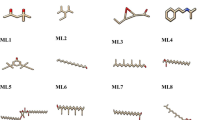Abstract—
The priority direction of the pharmaceutical composition Phytoladaptogene (PLA) development based on the prediction of biological activity spectra for several secondary metabolites of medicinal plants using the PASS computer program and validation in vitro of the prediction result was determined. PLA is a complex of structurally diverse small organic compounds including biologically active substances of phytoadaptogenes (ginsenosides from Panax ginseng, rhodionin from Rhodiola rosea and others) compiled considering previously developed pharmaceutical compositions. Two variants of the pharmaceutical composition were studied—major (22 compounds) and minor (13 compounds) ones. The probability of activity exceeds the probability of inactivity for 1400 out of 1945 pharmacological effects and mechanisms predicted by PASS for the major version of PLA. The wide range of predicted activities is mainly due to the compounds' low structural similarity to each other. An in silico prediction indicates the possibilities of antitumor properties against bladder, stomach, colon, ovarian and cervical cancers both for minor and major PLA compositions. It was found that the highest probability values of activity are predicted for three mechanisms: Apoptosis agonist, Caspase 3 stimulant, and Transcription factor NF kappa B inhibitor. According to the PharmaExpert program, they are associated with the antitumor effect against bladder cancer. Experimental validation was performed in vitro on the human bladder cancer cell line RT-112. As a result of the MTT test the cytotoxicity of the PLA major variant was found to be higher than that of the minor one. In the in vitro experiments using two methods—double staining with annexin V and propidium iodide as well as detection of active caspase 3 in cells—the death of bladder cancer cells by the apoptosis mechanism was also confirmed. The data obtained correspond to the results of the prediction and indicate the major PLA composition advantages. Phytoladaptogene can become the basis for the development of a drug with antitumor activity against bladder cancer. Antitumor activity predicted by PASS for other cancers may be the subject of further studies.










Similar content being viewed by others
REFERENCES
Rana, J.S., Khan, S.S., Lloyd-Jones, D.M., and Sidney, S., Journal of General Internal Medicine, 2020, 1–2.
Bray, F., Ferlay, J., Soerjomataram, I., Siegel, R. L., Torre, L. A., and Jemal, A., CA: a Cancer Journal for Clinicians, 2018, vol. 68, no. 6, pp. 394–424.
Wang, S., Dong, G., and Sheng, C., Chemical Reviews, 2019, vol. 119, no. 6, pp. 4180–4220.
Newman, D.J. and Cragg, G.M. Journal of Natural Products, 2020, vol. 83, no. 3, pp. 770–803.
Bhanot, A., Sharma, R., and Noolvi, M.N., (2011) International Journal of Phytomedicine, vol. 3, no. 1, 09.
Chen, Y., and Kirchmair, J., Molecular Informatics, 2020, vol. 39, no. 12, 2000171.
Bocharova, O.A., Baryshnikova, M.A., Zajchik, B.C., Karpova, R.V., Bocharov, E.V., Vashakmadze, L.A., Kazeev, I.V., Kucheryanu, V.G., Kosorukov, V.S., Matveev, V.B., Stilidi, I.S., Rus. Patent no. 2747147, registration date April 28, 2021.
Bocharova, O.A., Karpova, R.V. Bocharov, E.V., Vershinskaya, A.A., Baryshnikova, M.A., Kazeev, I.V., Kucheryanu, V.G., and Kiselevskiy, M.V., Rus. Bioter. Jurn., 2020, vol. 19, vol. 4, pp. 12–20. https://doi.org/10.17650/1726-9784-2019-19-2-13-2153-58
Poroikov, V.V., Biomeditsinskaya Khimiya, 2020, vol. 66, no. 1, pp. 30−41.
Filimonov, D.A., Druzhilovskiy, D.S., Lagunin, A.A., Gloriozova, T.A., Rudik, A.V., Dmitriev, A.V., and Poroikov, V.V., Biomedical Chemistry: Research and Methods, 2018, vol. 1, no. 1, e00004.
Filimonov, D., Poroikov, V., Borodina, Y., and Gloriozova, T., Journal of Chemical Information and Computer Sciences, 1999, vol. 39, no. 4, pp. 666–670.
Lagunin, A.A., Goel, R.K., Gawande, D.Y., Pahwa, P., Gloriozova, T.A., Dmitriev, A.V., and Poroikov, V.V., Natural Product Reports, 2014, vol. 31, no. 11, pp. 1585–1611.
Goel, R.K., Gawande, D.Y., Lagunin, A.A., and Poroikov, V.V., SAR and QSAR in Environmental Research, 2018, vol. 29, no. 1, pp. 69–81.
Mosmann, T., Journal of Immunological Methods, 1983, vol. 65, nos. 1–2, pp. 55–63.
Funding
The work was performed in the framework of the Russian Federation Fundamental Research Program for the long-term period for 2021−2030.
Author information
Authors and Affiliations
Corresponding author
Ethics declarations
CONFLICT OF INTEREST
The authors declare that they have no conflict of interest.
COMPLIANCE WITH ETHICAL STANDARDS
This article does not contain any research involving humans or the use of animals as objects.
Additional information
The article was translated by the author (N.S. Ionov).
Rights and permissions
About this article
Cite this article
Ionov, N.S., Baryshnikova, M.A., Bocharov, E.V. et al. Possibilities of in Silico Estimations for the Development of the Pharmaceutical Composition Phytoladaptogene Cytotoxic for Bladder Cancer Cells. Biochem. Moscow Suppl. Ser. B 15, 290–300 (2021). https://doi.org/10.1134/S1990750821040041
Received:
Revised:
Accepted:
Published:
Issue Date:
DOI: https://doi.org/10.1134/S1990750821040041




